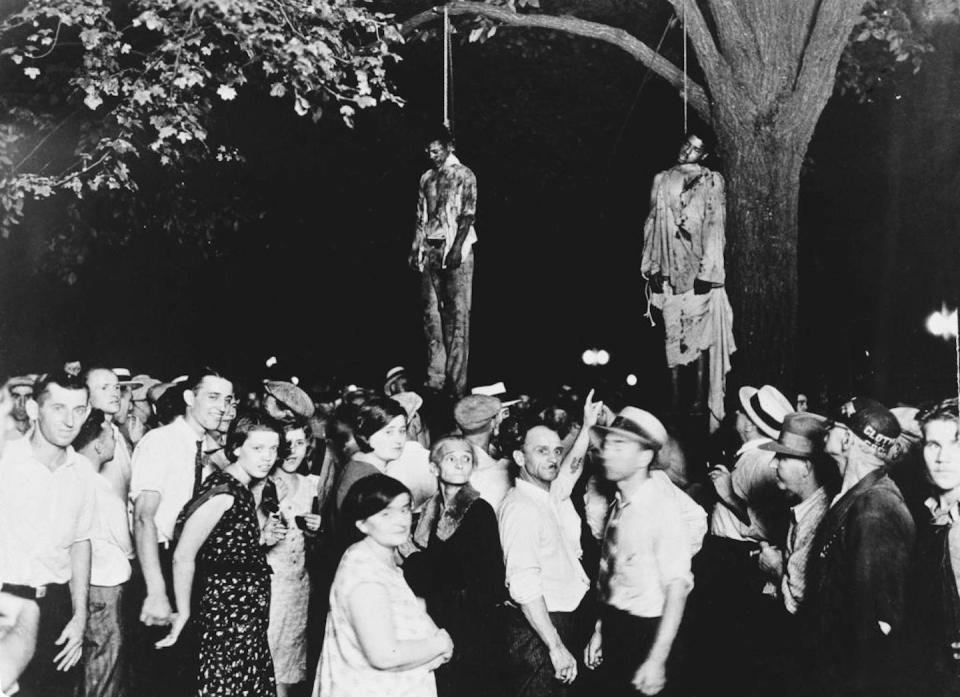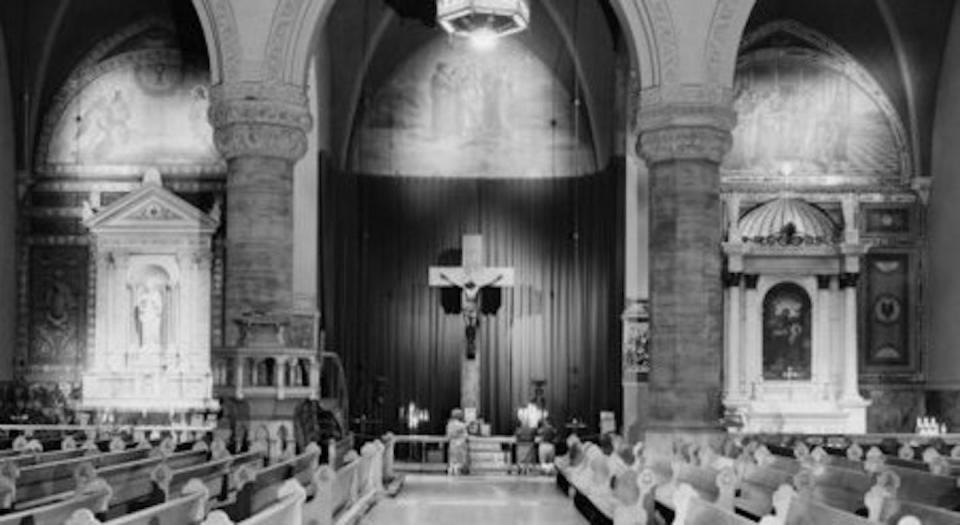Sixty-five years ago, on July 17, 1959, Billie Holiday died at Metropolitan Hospital in New York. The 44-year-old singer arrived after being turned away from a nearby charity hospital on evidence of drug use, then lay for hours on a stretcher in the hallway, unrecognized and unattended. Her estate amounted to 70 cents in the bank and a roll of bills concealed on her person, her share of the payment for a tabloid interview she gave on her deathbed.
Today, Holiday is revered as one of the most influential musical artists of all time. Time magazine named her 1939 recording of “Strange Fruit” the song of the 20th century. “In this sad, shadowy song about lynching in the South,” Time wrote in 1999, “history’s greatest jazz singer comes to terms with history itself.”
Abel Meeropol, a New York City teacher and songwriter who used the pen name Lewis Allan, wrote “Strange Fruit” after seeing a photograph of a lynching that shocked and haunted him: “Black body swinging in the Southern breeze / Strange fruit hanging from the poplar trees.”
Holiday’s rendition of Meeropol’s song remains as stunning – and searing – today as when it was first recorded. “It hits, hard,” syndicated columnist Samuel Grafton wrote soon after the record’s release in 1939. “It is as if a game of let’s pretend had ended.”
I’m a scholar of American religion, literature, and the arts, and I’m interested in the ways that even powerfully secular works draw energy from religious narratives of justice, injustice, truth-telling and redemption. I find “Strange Fruit” a resonant example.
Unflinching lyrics
Like so many composers whose songs Holiday recorded – George and Ira Gershwin, Irving Berlin, Jerome Kern – Meeropol came from a family of Jewish immigrants to America who fled antisemitic violence in Europe.
Two Great Migrations defined America in the early 1900s: rural South to industrial North, and Old World to New. Both were driven, in part, by the desire to leave racial terror behind.
Together, these migrations enabled some of the most enduring musical collaborations of the 20th century. Thematically, the joint productions of Black and Jewish musical artists – Broadway productions of “Show Boat” and “Porgy and Bess,” Holiday’s performances with Benny Goodman and Artie Shaw – tended to sidestep the brute realities of prejudice, focusing instead on the luxury of ordinary happiness and unhappiness.
“Strange Fruit” was different. The song gazes unflinchingly on the “strange fruit” of the title: hanged, burned and mangled flesh left to rot on a tree.
Well into the 20th century, white vigilante mobs murdered thousands of Black Americans with impunity: lynching then leaving their bodies on display as a terrorist spectacle.


Meeropol first jotted the song’s words and music on the back of a cabaret program dated Nov. 13, 1938 – four days after Kristallnacht, the night of murderous anti-Jewish rampages throughout Nazi Germany that became a tipping point for the Holocaust.
For Meeropol, a labor activist and a secular Jew, Black and Jewish Americans marched shoulder to shoulder in the cause of freedom from injustice. In another poem, he connected anti-Black violence with the persecutions of Jews:
I am a Jew.
How may I tell?
The Negro lynched
Reminds me well
I am a Jew.
Black Christ
As Meeropol linked anti-Black and anti-Jewish prejudice, many Black Christians also connected their suffering with that of the Hebrew slaves in the Bible – and with Jesus’ own.
According to theologian James Cone, “Black ministers preached about Jesus’ death more than any other theme because they saw in Jesus’ suffering and persecution a parallel to their own encounter with slavery, segregation, and the lynching tree.”
In the decade Holiday recorded “Strange Fruit,” Harlem Renaissance writers W.E.B. Du Bois, Countee Cullen and Langston Hughes all centered works around the figure of the crucified Black Christ.
Most African American Christians belong to Protestant churches, but Holiday did not. As a child she was baptized Catholic at a convent reform school, Baltimore’s House of the Good Shepherd for Colored Girls, where she was twice sent by the courts. She remained ambivalently Catholic for the whole of her life.
The filled cross
Protestant churches commonly display the “empty” cross, showing the instrument of Jesus’ execution, but not his body. The message of the empty cross is resurrection and new life. According to the Christian story, Jesus was crucified, buried and rose from the dead to redeem humankind from sin.
In Catholic settings, one is more likely to find the “filled” cross: the body of Jesus with arms outstretched, hands and feet nailed to the wood. The crucifix emphasizes the agony of Jesus’ death and his solidarity with all who suffer.


The filled cross also communicates the message that the crucifixion of Christ – God in human form – is not a once-and-for-all event.
“When [Meeropol] showed me that poem,” Holiday said of “Strange Fruit,” “I dug it right off” because it “seemed to spell out all the things that had killed Pop.” Her father, jazz guitarist Clarence Holiday, died at 39 while touring in Texas. She believed he’d been refused lifesaving care because of his race.
Holiday’s “Strange Fruit” evokes the filled cross in its testament to lynching as ongoing reality. “It still depresses me every time I sing it,” Holiday said in her autobiography. “But I have to keep singing it … the things that killed him are still happening in the South.”
Journalist Vernon Jarrett recalled seeing Holiday perform in 1947. She was “singing this song as though this was for real, as though she had just witnessed a lynching,” Jarrett said of “Strange Fruit.” “There was a sense of resignation, as if ‘these people are going to have power for a long time and I can’t do a damn thing about it except put it in a song.‘”
Ongoing testament
Keeping company with brokenness, rather than transcending or overcoming it, also describes Holiday’s way of relating to others in precarious circumstances. Her Harlem apartment, she said, was a “combination YMCA, boardinghouse for broke musicians, soup kitchen for anyone with a hard-luck story, community center, and after-hours joint.”
A 1943 papal encyclical described the church itself similarly, as a place of shared pain, solace and sustenance. Anyone without money “could go there and eat,” poet and jazz vocalist Babs Gonzales recalled of Holiday’s place. “She fed everybody in New York for four years.”
Holiday closed sets with “Strange Fruit” from 1939 until the final months of her life. In making it her trademark song, she offered solidarity and faithful witness to racial violence and injustice, not the remedy for these. But her testament carried extraordinary power.
Shortly after the 2020 murder of George Floyd, Bruce Springsteen, a fellow Catholic with “misgivings,” made a playlist for America. First on his list was “Strange Fruit.”
Asked whether he was optimistic about the future, Springsteen answered in the spirit of Holiday: witness, not triumph. “I don’t think anybody truly knows where we’re going from here,” he told writer David Brooks. But everyone “can see right now that the status quo is not okay. And that’s progress.”
This article is republished from The Conversation, a nonprofit, independent news organization bringing you facts and trustworthy analysis to help you make sense of our complex world. It was written by: Tracy Fessenden, Arizona State University
Read more:
Tracy Fessenden has received funding from the National Endowment for the Humanities, the Henry Luce Foundation, and the American Council of Learned Societies.
